| Solar eclipse of July 16, 2186 | |
|---|---|
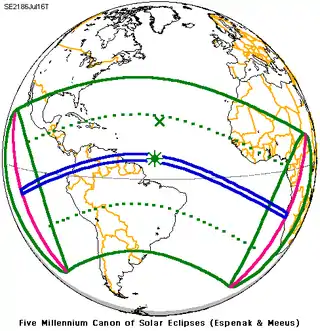 Map | |
| Type of eclipse | |
| Nature | Total |
| Gamma | −0.2396 |
| Magnitude | 1.0805 |
| Maximum eclipse | |
| Duration | 449 sec (7 m 29 s) |
| Coordinates | 7°24′N 46°30′W / 7.4°N 46.5°W |
| Max. width of band | 267 km (166 mi) |
| Times (UTC) | |
| Greatest eclipse | 15:14:54 |
| References | |
| Saros | 139 (39 of 71) |
| Catalog # (SE5000) | 9933 |
A total solar eclipse will occur on July 16, 2186, which will be the longest total eclipse for thousands of years. The eclipse will pass over the southern Galápagos Islands (with a total eclipse of 4 minutes occurring over the southern tip of Española Island), the northern tip of Ecuador (with a total eclipse of 3 minutes and 26 seconds on Isla Santa Rosa), central Colombia (4 minutes and 50 seconds over Bogota), central Venezuela, and northern Guyana (7 minutes and 4 seconds just north of Anna Regina).[1]
Extreme duration
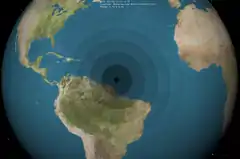
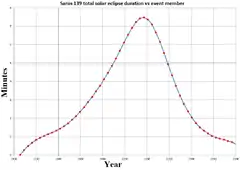
This will be the longest total solar eclipse between 4000 BC and at least AD 6000 (10,000 years), lasting a maximum of 7 minutes, 29.22 seconds. The factors that will make this such a long eclipse are:
- The Earth being very near aphelion (furthest away from the Sun in its elliptical orbit, making its angular diameter nearly as small as possible). This occurs around July 6th.
- The Moon being almost exactly at perigee (making its angular diameter as large as possible). The moment of greatest eclipse will be just 50 minutes after perigee.[2]
- The midpoint of the eclipse being very close to the Earth's equator, where the Earth's rotational velocity is greatest.
- The midpoint of the eclipse being near the subsolar point (the part of the Earth closest to the Sun, and therefore also closest to the Moon during an eclipse).
- The vector of the eclipse path at the midpoint of the eclipse aligning with the vector of the Earth's rotation (i.e. not diagonal but due east). For solar eclipses at the ascending node (odd numbered saros) this occurs approximately 12 days after the summer solstice.[3][4]
The longest historical total eclipse lasted 7 minutes 27.54 seconds on June 15, 743 BC.[5] The longest eclipse theoretically possible for the 3rd millennium is 7 minutes and 32 seconds.[6]
Related eclipses
Saros 139
It is a part of saros series 139, repeating every 18 years, 11 days, 8 hours, containing 71 events. The series started with partial solar eclipse on May 17, 1501. It contains hybrid eclipses on August 11, 1627 through to December 9, 1825 and total eclipses from December 21, 1843 through to March 26, 2601. The series ends at member 71 as a partial eclipse on July 3, 2763. Its eclipses are entabulated in three columns; each one in the same column, every third eclipse, is one exeligmos apart so cast shadows over approximately the same parts of the Earth.
The solar eclipse of June 13, 2132 will be the longest total solar eclipse since July 11, 1991 at 6 minutes, 55.02 seconds.
The longest duration of totality will be produced by member 39 at 7 minutes, 29.22 seconds on July 16, 2186.[7] After that date each duration will decrease, until the series end. This date is the longest solar eclipse computed between 4000 BC and 6000 AD.[8] Saros series eclipses are during the Moon’s ascending node (a term related to our equator and polar-naming conventions).
| Series members 24–45 occur between 1901 and 2300 | ||
|---|---|---|
| 24 | 25 | 26 |
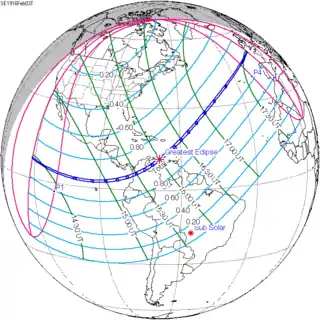 February 3, 1916 |
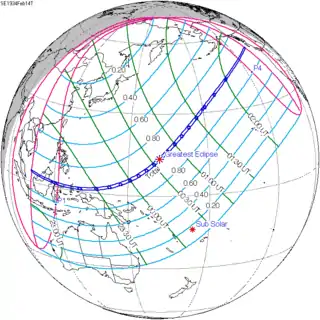 February 14, 1934 |
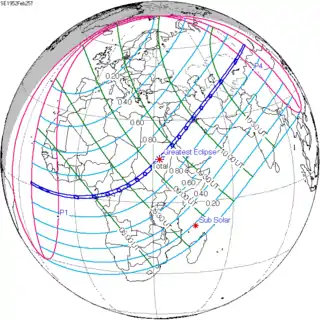 February 25, 1952 |
| 27 | 28 | 29 |
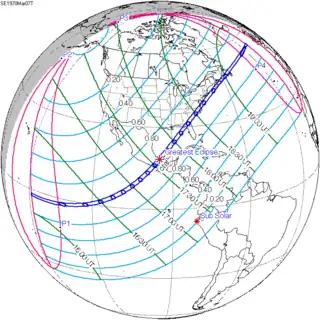 March 7, 1970 |
 March 18, 1988 |
 March 29, 2006 |
| 30 | 31 | 32 |
 April 8, 2024 |
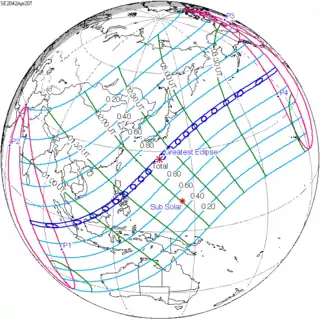 April 20, 2042 |
 April 30, 2060 |
| 33 | 34 | 35 |
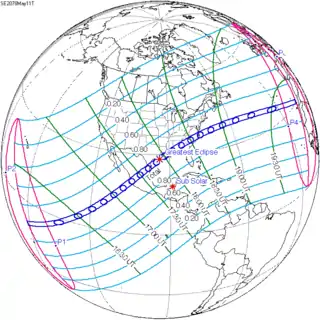 May 11, 2078 |
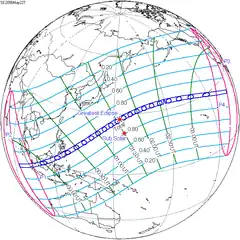 May 22, 2096 |
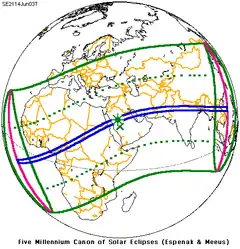 June 3, 2114 |
| 36 | 37 | 38 |
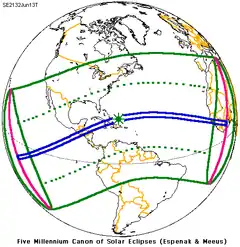 June 13, 2132 |
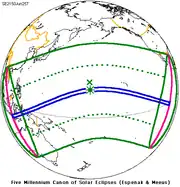 June 25, 2150 |
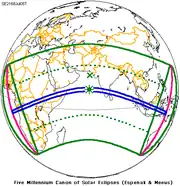 July 5, 2168 |
| 39 | 40 | 41 |
 July 16, 2186 |
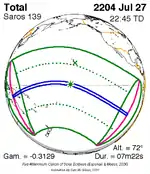 July 27, 2204 |
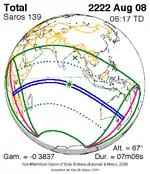 August 8, 2222 |
| 42 | 43 | 44 |
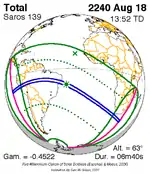 August 18, 2240 |
 August 29, 2258 |
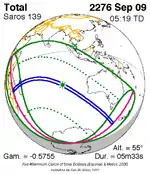 September 9, 2276 |
| 45 | ||
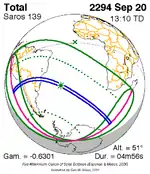 September 20, 2294 | ||
References
- ↑ Total Solar Eclipse of 2186 July 16 - Interactive Eclipse Path Using Google Maps NASA Eclipse Website, Fred Espenak.
- ↑ "Lunar Perigee and Apogee Calculator".
- ↑ Meeus, J. (December 2003). "The maximum possible duration of a total solar eclipse". Journal of the British Astronomical Association. 113 (6): 343–348. Bibcode:2003JBAA..113..343M.
- ↑ M. Littman, et al.
- ↑ Ten Millennium Catalog of Long Solar Eclipses, -3999 to +6000 (4000 BCE to 6000 CE) Fred Espenak.
- ↑ Mark Littman; Fred Espenak; Ken Wilcox (2008). "A Quest to Understand". Totality: Eclipses of the Sun (3rd ed.). New York: Oxford University Press Inc. ISBN 978-0-19-953209-4.
"Eclipse expert Jean Meeus calculates the maximum possible eclipse duration of totality in a solar eclipse is currently 7 minutes 32 seconds.
- ↑ Saros Series Catalog of Solar Eclipses NASA Eclipse Web Site.
- ↑ Ten Millennium Catalog of Long Solar Eclipses, −3999 to +6000 (4000 BCE to 6000 CE) Fred Espenak.
.jpg.webp)

